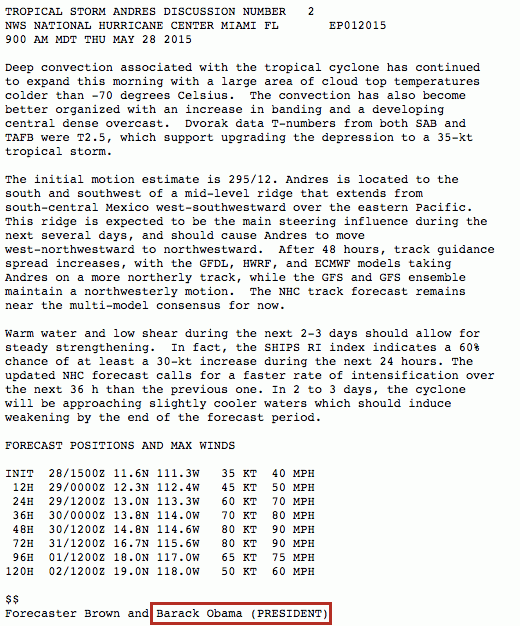News•May 28, 2015
Obama Issues Tropical Storm Forecast, Does Twitter Q&A

By Brian Kahn
Add another title to Barack Obama's resume: hurricane forecaster.
On Thursday, President Obama spent the morning touring the National Hurricane Center (NHC) in Miami and getting a briefing on the coming Atlantic hurricane season, which begins on June 1. However, the eastern Pacific region saw its hurricane season start two weeks ago on May 15 and as luck would have it, the first named storm of the season is currently churning in the basin.
Obama helped issued the Thursday morning forecast for Andres with his name and title (just in case NHC happened to have another Barack Obama on staff) appearing next one of the NHC's regular forecasters. It's unlikely Obama did much of the forecasting, given his lack of a meteorological background and the fact that he was in Miami with bigger issues on his mind, namely the start of hurricane season.

The National Oceanic and Atmospheric Administration is forecasting a below average hurricane season in the Atlantic basin in large part because of the strengthening El Niño. Tropical storms have trouble forming in the Atlantic thanks to wind patterns associated with the phenomenon.
However, despite increased odds for a quiet year and a multi-year major hurricane drought in the U.S., forecasters have warned that it only takes one storm to wreak serious damage along the East Coast. Notably, 1992 saw only seven named storms, but one of them was Hurricane Andrew, which became a massive Category 5 storm that made a direct hit on Florida.
And though El Niño generally leads to a quiet Atlantic hurricane season, in the eastern Pacific, it can increase activity and send storm's churning toward Obama's home state of Hawaii. With El Niño-like conditions burbling last August, two storms beelined for the island chain with one, Hurricane Iselle, making landfall as the strongest storm on record to hit the Big Island.
Following the forecast briefing, Obama took questions from his new Twitter account about climate change. The impact of climate change on tropical storms around the world indicates that there will likely be fewer storms but those that do form will be more intense. Sea level rise is also likely increase the damage from storm surge and adaptation measures could save trillions in losses. Here are a few questions Obama received and answered:
.@ZCarlander more severe weather events lead to displacement, scarcity, stressed populations; all increase likelihood of global conflict.
— President Obama (@POTUS) May 28, 2015
.@arianastover Kids instinctively understand importance of environment, impact on animals, health. Weave it into science and social studies
— President Obama (@POTUS) May 28, 2015
Thanks for the questions! This was fun. I've got to run, but let’s do it again soon. Tell me what you're doing to #ActOnClimate.
— President Obama (@POTUS) May 28, 2015
You May Also Like:
Climate Change Could Melt Everest Region’s Glaciers
Report: U.S. Can Make Good on Climate Pledge — Barely
Will The West Ever Be Able To Live With Fire?
10 Years After Katrina, Slow Hurricane Season Expected